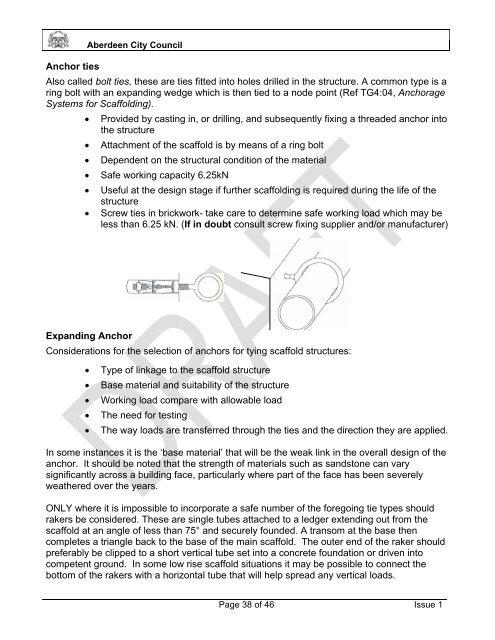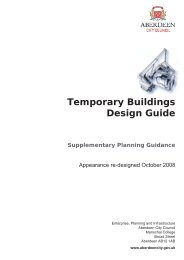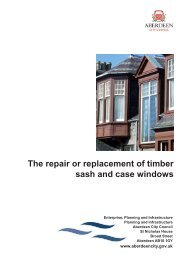Scaffold Protocol - Aberdeen City Council
Scaffold Protocol - Aberdeen City Council
Scaffold Protocol - Aberdeen City Council
- No tags were found...
You also want an ePaper? Increase the reach of your titles
YUMPU automatically turns print PDFs into web optimized ePapers that Google loves.
<strong>Aberdeen</strong> <strong>City</strong> <strong>Council</strong>Anchor tiesAlso called bolt ties, these are ties fitted into holes drilled in the structure. A common type is aring bolt with an expanding wedge which is then tied to a node point (Ref TG4:04, AnchorageSystems for <strong>Scaffold</strong>ing).• Provided by casting in, or drilling, and subsequently fixing a threaded anchor intothe structure• Attachment of the scaffold is by means of a ring bolt• Dependent on the structural condition of the material• Safe working capacity 6.25kN• Useful at the design stage if further scaffolding is required during the life of thestructure• Screw ties in brickwork- take care to determine safe working load which may beless than 6.25 kN. (If in doubt consult screw fixing supplier and/or manufacturer)Expanding AnchorConsiderations for the selection of anchors for tying scaffold structures:• Type of linkage to the scaffold structure• Base material and suitability of the structure• Working load compare with allowable load• The need for testing• The way loads are transferred through the ties and the direction they are applied.In some instances it is the ‘base material’ that will be the weak link in the overall design of theanchor. It should be noted that the strength of materials such as sandstone can varysignificantly across a building face, particularly where part of the face has been severelyweathered over the years.ONLY where it is impossible to incorporate a safe number of the foregoing tie types shouldrakers be considered. These are single tubes attached to a ledger extending out from thescaffold at an angle of less than 75° and securely founded. A transom at the base thencompletes a triangle back to the base of the main scaffold. The outer end of the raker shouldpreferably be clipped to a short vertical tube set into a concrete foundation or driven intocompetent ground. In some low rise scaffold situations it may be possible to connect thebottom of the rakers with a horizontal tube that will help spread any vertical loads.Page 38 of 46 Issue 1
















